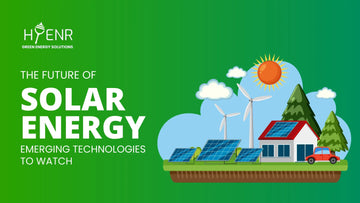Solar power is at the forefront of the sustainability revolution as the world approaches renewable energy solutions. The future of solar energy is becoming more and more promising due to rapid technological advancements and innovation. Emerging technologies are transforming how we harness and utilize solar power, making it more efficient, accessible, and cost-effective. From breakthrough photovoltaic materials to cutting-edge storage solutions, these advancements promise to reshape our energy landscape; we’ll explore the most promising solar technologies on the horizon and their potential to revolutionize the industry and drive a greener future.
1. Future Trends in Solar Energy
Increased Adoption of Solar Power: As solar technology's cost decreases and efficiency improves, more households and businesses opt for solar energy as a viable alternative to traditional power sources.
Growth in Solar Energy Storage: The development of advanced energy storage systems, such as lithium-ion and flow batteries, enables more efficient use of solar power, even when the sun isn't shining.
Smart Solar Grids: Integrating smart grids with solar power systems allows for better energy management and distribution, reducing waste and improving reliability.
2. What Are Perovskite Solar Cells?
Definition: Perovskite solar cells are a new type of photovoltaic technology made from materials with a specific crystal structure. They offer high efficiency at a lower cost compared to traditional silicon-based cells.
Benefits: These cells are lightweight, flexible, and have the potential for even higher efficiency rates, which makes them a promising option for a wide range of applications.
Current Developments: Researchers are striving to enhance the stability and longevity of perovskite solar cells to enable their commercial viability on a large scale.
3. Introduction to Solar Technology Innovations
Solar energy represents a beacon of hope and innovation in pursuing a cleaner, greener planet. Ground-breaking advancements in photovoltaic technology are at the forefront of this renewable revolution, introducing more efficient, versatile, and seamlessly integrated solar solutions.
Let’s explore these extraordinary innovations shaping our energy future and a testament to human ingenuity and our collective will to steward the Earth toward a sustainable path.
Next-Gen Photovoltaic Cells: Innovations such as tandem and bifacial solar cells are improving the efficiency and versatility of solar panels.
Building-Integrated Photovoltaics (BIPV): This technology seamlessly integrates solar power into building materials like windows and roof tiles.
Solar-Powered Transportation: Solar energy is also being integrated into vehicles, with solar-powered cars and charging stations becoming more common.
4. Emerging Renewable Energy Technologies
Hybrid Solar Systems: Combining solar power with other renewable energy sources, such as wind or geothermal, creates hybrid systems that offer more consistent energy production.
Floating Solar Farms Solar panels installed on bodies of water, such as lakes or reservoirs, are a growing trend. They help to save land space and improve efficiency through cooling effects.
Artificial Intelligence in Solar Energy: AI is being used to optimize the performance of solar systems, predict maintenance needs, and improve energy forecasting.
5. Basics of Solar Energy Efficiency

Panel Efficiency: A solar panel's efficiency indicates how much sunlight it can convert into usable electricity, with new technologies continually increasing these rates.
Energy Storage: Effective storage solutions are key to maximizing the efficiency of solar power. These solutions allow excess energy to be stored for use when sunlight is not available.
System Design: Proper system design, including the angle and placement of panels, is crucial for maximizing solar energy efficiency.
6. Advancements in Solar Power Generation
Concentrated Solar Power (CSP): CSP systems use mirrors or lenses to focus sunlight onto a small area, producing high temperatures to generate electricity.
Thin-Film Solar Panels: These panels consist of thin layers of photovoltaic material, providing flexibility and lightweight properties, making them suitable for various applications.
Energy Conversion Technologies: Innovations in materials and cell design are improving the efficiency of converting sunlight into electricity, reducing the cost of solar power generation.
7. Solar Energy for Beginners
Understanding Solar Power: Solar power is generated by converting sunlight into electricity using silicon photovoltaic cells.
Types of Solar Systems: There are several types of solar systems, including grid-tied, off-grid, and hybrid systems, each with its advantages and applications.
Getting Started: For beginners, starting with a small, grid-tied system is often the best way to explore the benefits of solar energy without a significant upfront investment.
8. Overview of Next-Gen Solar Panels
Tandem Solar Panels: These panels use various photovoltaic materials to capture a broader range of the solar spectrum, increasing efficiency.
Bifacial Solar Panels: Bifacial panels can gather solar energy from both sides, enhancing efficiency in specific environments like snowy regions or areas with reflective surfaces.
Flexible Solar Panels: Made from materials like thin-film or organic photovoltaics, these panels are lightweight and flexible, allowing for installation on various surfaces.
Solar Skins: This technology allows panels to mimic the appearance of roofing materials, blending aesthetics with functionality for BIPV solutions.
Quantum Dots: Tiny semiconductor particles that can boost the efficiency of solar panels by absorbing a broader spectrum of light.
Wireless Solar Energy Transmission: A ground-breaking concept that explores the potential for wireless transfer of solar energy, eliminating the need for physical grid connections.
By understanding these key trends and emerging technologies, individuals at the top of the funnel can gain a solid foundation in solar energy, setting the stage for deeper exploration and potential adoption of solar solutions.
Conclusion
The future of solar energy looks promising, with new technologies offering increased efficiency and affordability. Advancements such as perovskite solar cells, bifacial panels, and solar storage solutions are revolutionizing the landscape, potentially leading to greater adoption and a significant impact on renewable energy reliance worldwide.





